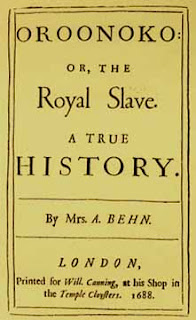Defining the "Others", or Defined by the "Others"? (Blogpost 5)

Aphra Behn ’s short novel Oroonoko: or The Royal Slave is the story of an African prince who falls in love with the beautiful Imoinda. Unfortunately for Oroonoko and Imoinda, their love is full of complications as Oroonoko’s grandfather, the King, is also in love with Imoinda and forces her into being his wife. Throughout the story, Oroonoko goes to great lengths to free Imoinda from her unwanted relationship with the King, but to no avail. Eventually, after being on the run for leading a slave revolt, after he has been enslaved, Oroonoko decides that it would be best to give Imoinda an honorable death so that she and their unborn child will not have to endure the wrath of the Englishmen. At the end of the story, after he has killed Imoinda, Oroonoko is caught and endures an inhumane death. Okay, so I probably should have put a spoiler alert before that first paragraph. Yeah, I should have. However, if you have not read Behn’s Oroonoko , you should still give it a read. I am su...

